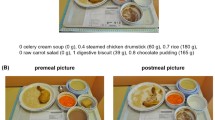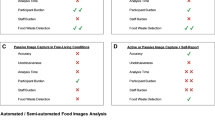Abstract
Objective: The primary objective of this study was to test the comparability of digital photography and visual estimation procedures for estimating food intake. Research methods and procedures: The study sample included 71 breakfast meals and 59 lunch meals eaten in a university cafeteria during a single day. A total of 66 different foods were employed as test foods that could be selected by the students. Food selections and plate waste, as estimated by digital photography and visual estimation, were compared. For digital photography, three observers independently estimated portion sizes of each food item based upon digital photographs. One observer estimated portion sizes in the cafeteria setting, using visual estimation, a method that has been validated in other studies. Results: To test the accuracy of the two procedures for measuring food intake, the estimates of food weights derived from both procedures were compared using Bland-Altman regression. In comparison to visual estimation, the digital photography method yielded comparable estimates of food selections, plate waste, and total food intake for seven of nine comparisons. The two methods of estimating food portions yielded comparable results for most (78%) types of foods. The two methods also yielded similar variability. Discussion: These findings suggest that the digital photography method is an alternative to the traditional method of estimating food intake via direct observation.
Similar content being viewed by others
References
Fox T.A., Heimendinger J., Block G.: Telephone surveys as a method for obtaining dietary information: A review. J. Am. Diet. Assoc., 92, 729–732, 1992.
Beaton G.H., Burema J., Ritenbaugh C.: Errors in the interpretation of dietary assessments. Am. J. Clin. Nutr., 65, Suppl., 1100S–1107S, 1997.
Tran K.M., Johnson R.K., Soultanakis R.P., Matthews D.E.: In-person versus telephone administered multiple-pass 24-hour recalls in women: Validation with doubly labeled water. J. Am. Diet. Assoc., 100, 777–783, 2000.
DeLany J.P.: Role of energy expenditure in the development of pediatric obesity. Am. J. Clin. Nutr., 68, Suppl., 950S–955S, 1998.
Johnson R.K., Soultanakis P., Matthews D.E.: Literacy and body fatness are associated with underreporting of energy intake in US low-income women using the multiple-pass 24-hour recall: a doubly labeled water study. J. Am. Diet. Assoc., 98, 1136–1140, 1998.
Kretsch M.J.K., Fong A.K.H., Green M.W.: Behavioral and body size correlates of energy intake underreporting by obese and normal-weight women. J. Am. Diet. Assoc., 99, 300–306, 1999.
Kristal A.R., Andrilla H.A., Koepsell T.D., Diehr P.H., Cheadle A.: Dietary assessment instruments are susceptible to intervention-associated response set bias. J. Am. Diet. Assoc., 98, 40–43, 1998.
Price G.M., Paul A.A., Cole T.J., Wadsworth M.E.: Characteristics of the low-energy reporters in a longitudinal national dietary survey. Br. J. Nutr., 77, 833–851, 1997.
Pryer J.A., Vrijheid M., Nichols R., Kiggins M., Elliott P.: Who are the “low energy reporters” in the dietary and nutritional survey of British adults? Int. J. Epidemiol., 26, 146–154, 1997.
Schoeller D.A.: How accurate is self-reported dietary energy intake? Nutr. Rev., 48, 373–379, 1990.
Comstock E.M., St. Pierre R.G., Mackiernan Y.D.: Measuring individual plate waste in school. Visual estimation and children’s ratings vs. actual weighing of plate waste. J. Am. Diet. Assoc., 79, 290–296, 1981.
Lachance P.A.: Simple research techniques for school foodservice part II: Measuring plate waste. Food Service Journal, 30, 68–76, 1976.
Wolper C., Heshka S., Heymsfield S.B.: Measuring food intake: An overview. In: Allison D. (Ed.), Handbook of assessment measures for eating behaviors and weight-related problems. Thousand Oaks, CA, Sage Publishing, 1995, pp. 215–240.
Auld G.W., Romaniello C., Heimendinger J., Hambidge C., Hambidge M.: Outcomes from a school-based nutrition education program alternating special resource teachers and classroom teachers. J. Sch. Health, 69, 403–410, 1999.
Davidson F.R., Hayek L.E., Altschul A.M.: Towards accurate assessment of Children’s food consumption. Ecol. Food Nutr., 18, 309–317, 1986.
Friedman B.J., Hurd-Crixell S.L.: Nutrition intake of children eating school breakfast. J. Am. Diet. Assoc., 99, 219–221, 1999.
Simmons-Morton B.G., Forthofer R., Huang I.W., Baranowski T., Reed D.B., Fleishman R.: Reliability of visual estimate of school children’s consumption of bag lunches. J. Am. Diet. Assoc., 92, 219–221, 1992.
Crawford P.B., Obarzanek E., Morrison J., Sabry Z.I.: Comparative advantage of 3-day food records over 24-hour recall and 5-day food frequency validated by observation of 9- and 10-year-old girls. J. Am. Diet. Assoc., 94, 626–630, 1994.
Domel S.B., Baranowski T., Leonard S.B., Davis H., Riley P., Baranowski J.: Accuracy of fourth- and fifthgrade students’ food records compared with school-lunch observations. Am. J. Clin. Nutr., 59, Suppl., 218S–220S, 1994.
Mertz W.: Food intake measurement: is there a “gold standard”? J. Am. Diet. Assoc., 92, 1463–1465, 1992.
Dubois S.: Accuracy of visual estimates of plate waste in the determination of food consumption. J. Am. Diet. Assoc., 90, 382–387, 1990.
Kirks B.A., Wolff H.K.: A comparison of methods for plate waste determinations. J. Am. Diet. Assoc., 85, 328–331, 1985.
Shankar A.V., Gittelsohn J., Stallings R., West K.P. jr., Gnywali T., Dhungel C., Dahal B.: Comparison of visual estimates of children’s portion sizes both shared-plate and individual-plate conditions. J. Am. Diet. Assoc., 101, 47–52, 2001.
Williamson D.A., Allen H.R., Martin P.D., Alfonso A., Gerald B.G., Hunt A.: Comparision of digital photography to weighed and visual estimation of portion sizes. J. Am. Diet. Assoc., 103, 1139–1145, 2003.
Williamson D.A., Davis Martin P., Allen H.R., Most M.M., Alfonso A., Thomas V., Ryan D.H.: Changes in food intake and body weight associated with basic combat training. Military Med., 167, 248–253, 2002.
Author information
Authors and Affiliations
Corresponding author
Rights and permissions
About this article
Cite this article
Williamson, D.A., Allen, H.R., Martin, P.D. et al. Digital photography: A new method for estimating food intake in cafeteria settings. Eat Weight Disord 9, 24–28 (2004). https://doi.org/10.1007/BF03325041
Published:
Issue Date:
DOI: https://doi.org/10.1007/BF03325041




